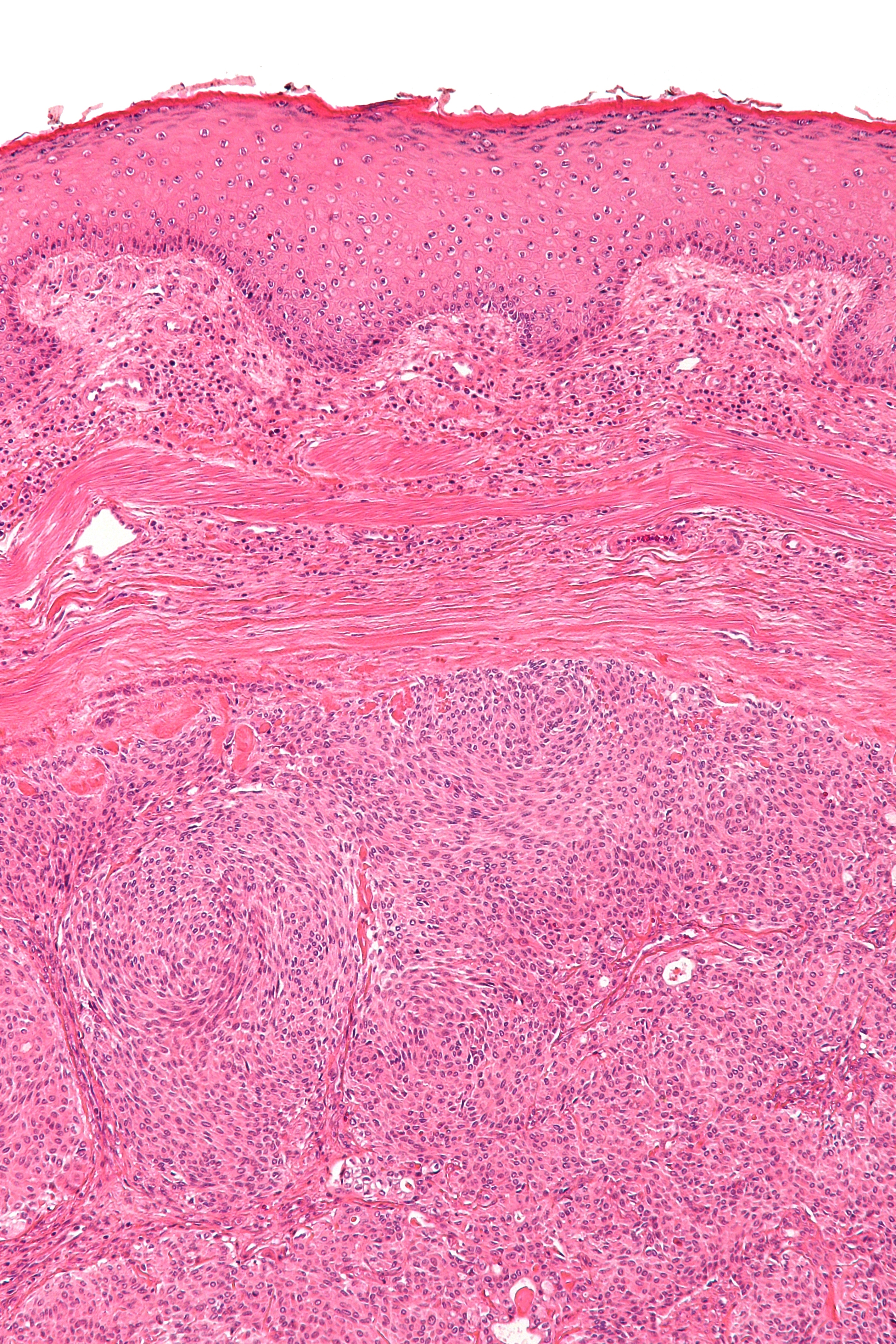Hidradenoma
Editor-In-Chief: Prab R Tumpati, MD
Obesity, Sleep & Internal medicine
Founder, WikiMD Wellnesspedia &
W8MD medical weight loss NYC and sleep center NYC
| Hidradenoma | |
|---|---|

| |
| Synonyms | Acrospiroma, clear cell hidradenoma, nodular hidradenoma |
| Pronounce | N/A |
| Specialty | Dermatology |
| Symptoms | Solitary, slow-growing nodule |
| Complications | N/A |
| Onset | Middle-aged adults |
| Duration | Chronic |
| Types | N/A |
| Causes | Unknown |
| Risks | Genetic predisposition, sun exposure |
| Diagnosis | Biopsy and histopathology |
| Differential diagnosis | Eccrine poroma, trichoepithelioma, basal cell carcinoma |
| Prevention | N/A |
| Treatment | Surgical excision |
| Medication | N/A |
| Prognosis | Excellent with complete excision |
| Frequency | Rare |
| Deaths | N/A |
Hidradenoma is a benign tumor originating from the sweat glands. These tumors, also known as nodular hidradenoma or clear cell hidradenoma, are most commonly found in the skin and can occur anywhere on the body but are most frequently located on the head, neck, torso, and extremities. Hidradenomas are part of a group of tumors that arise from the eccrine or apocrine sweat glands, with the latter being more commonly associated with this condition.
Symptoms and Diagnosis[edit | edit source]
The presentation of a hidradenoma typically includes a solitary, well-defined nodule that may vary in color from skin-toned to blue or black. These nodules are usually asymptomatic but can become painful or tender, especially if they become infected or undergo rapid growth. The size of the tumors can range from a few millimeters to several centimeters in diameter. Diagnosis of hidradenoma is primarily based on the clinical examination and histopathological analysis of the biopsy specimen. Histologically, hidradenomas are characterized by solid and cystic areas with cells that have clear cytoplasm and round nuclei, which is indicative of their eccrine or apocrine origin.
Treatment[edit | edit source]
The standard treatment for hidradenoma is surgical excision. Complete removal of the tumor is recommended to prevent recurrence, which is uncommon but can occur. In cases where the tumor is large or has recurred multiple times, a more extensive surgical procedure may be necessary to ensure complete removal. There is no established role for chemotherapy or radiation therapy in the treatment of hidradenomas, as they are benign tumors.
Prognosis[edit | edit source]
The prognosis for individuals with hidradenoma is generally excellent, as these tumors are benign and do not metastasize. However, there is a rare potential for malignant transformation into a malignant hidradenoma, also known as hidradenocarcinoma. Regular follow-up with a dermatologist is recommended to monitor for any changes in the tumor or the development of new lesions.
Epidemiology[edit | edit source]
Hidradenomas are relatively rare, and their exact incidence is not well-documented. They can occur at any age but are most commonly diagnosed in adults. There is no clear gender predilection, although some studies suggest a slight female predominance.
See Also[edit | edit source]
Search WikiMD
Ad.Tired of being Overweight? Try W8MD's physician weight loss program.
Semaglutide (Ozempic / Wegovy and Tirzepatide (Mounjaro / Zepbound) available.
Advertise on WikiMD
|
WikiMD's Wellness Encyclopedia |
| Let Food Be Thy Medicine Medicine Thy Food - Hippocrates |
Translate this page: - East Asian
中文,
日本,
한국어,
South Asian
हिन्दी,
தமிழ்,
తెలుగు,
Urdu,
ಕನ್ನಡ,
Southeast Asian
Indonesian,
Vietnamese,
Thai,
မြန်မာဘာသာ,
বাংলা
European
español,
Deutsch,
français,
Greek,
português do Brasil,
polski,
română,
русский,
Nederlands,
norsk,
svenska,
suomi,
Italian
Middle Eastern & African
عربى,
Turkish,
Persian,
Hebrew,
Afrikaans,
isiZulu,
Kiswahili,
Other
Bulgarian,
Hungarian,
Czech,
Swedish,
മലയാളം,
मराठी,
ਪੰਜਾਬੀ,
ગુજરાતી,
Portuguese,
Ukrainian
Medical Disclaimer: WikiMD is not a substitute for professional medical advice. The information on WikiMD is provided as an information resource only, may be incorrect, outdated or misleading, and is not to be used or relied on for any diagnostic or treatment purposes. Please consult your health care provider before making any healthcare decisions or for guidance about a specific medical condition. WikiMD expressly disclaims responsibility, and shall have no liability, for any damages, loss, injury, or liability whatsoever suffered as a result of your reliance on the information contained in this site. By visiting this site you agree to the foregoing terms and conditions, which may from time to time be changed or supplemented by WikiMD. If you do not agree to the foregoing terms and conditions, you should not enter or use this site. See full disclaimer.
Credits:Most images are courtesy of Wikimedia commons, and templates, categories Wikipedia, licensed under CC BY SA or similar.
Contributors: Prab R. Tumpati, MD





